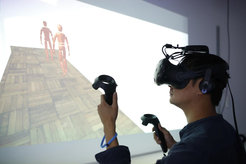Virtual Reality Lab
What decisions do people make when faced with sudden dangers in road traffic? Which routes do they use to escape burning buildings? How does the weather affect people’s driving? In 2018, a Virtual Reality Lab was set up at the Max Planck Institute for Human Development, allowing researchers to investigate these kinds of situations as realistically as possible but under controlled conditions.

In the Virtual Reality Lab (VR Lab), participants are immersed in a virtual world where they are observed as they react to specific situations and complete tasks. The tasks used are individually programmed for each experiment.
Various technologies make it possible to achieve a high degree of immersion in the lab, giving participants the feeling of moving through a real world. In addition to VR glasses, participants wear VR gloves, which allow them to use their hands in the virtual environment and provide a realistic sensation of touch. VR treadmills enable participants to move freely through the virtual world, and a VR driving simulator creates a realistic feeling of driving. A Motion Capture System is used to transfer participants’ physical movements to the virtual world. In this tracking method, participants’ movements in the real world are recorded and can then be analyzed and processed. In addition, eye tracking enables researchers to assess what participants look at, for how long, in which order, and how their pupils change in size.
To make participants’ experience of the virtual space as realistic as possible, objects such as chairs featured in the virtual environment are placed physically in the real environment, meaning that participants can actually sit down on a chair in virtual space. Other physical objects are scanned to make them visible in virtual reality. A full-body 3D scanner allows an avatar of the participant to be created, allowing their physical characteristics to be transferred to the virtual world.
